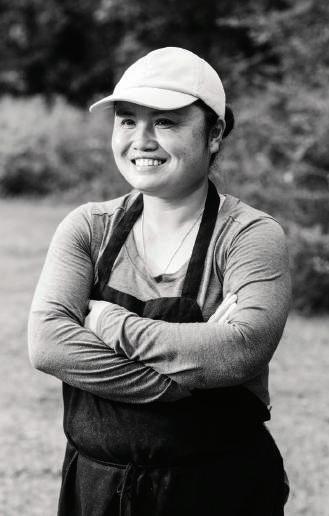
8 minute read
BAY TABLES
Lith Vining’s life has always been grounded in growing and cooking. As a child in Pak Lay, Laos, a small town on the Mekong River close to the Thai border, Vining, right, fed her family’s chickens and pigs in the morning and after school, helped water and harvest the many plants and herbs in her family’s garden, and, along with her two brothers, learned to make rice in a bucket at a young age.
Her family ate what they grew, cooked meals together and rarely bought from the store. Vining’s parents owned a farm with homegrown rice for eating and peanuts and corn for selling. It took an hour to walk to the farm when she was growing up in the ’80s and ’90s, and Vining laughs when she tells me her niece now makes the trip on her motorcycle in just seven minutes.
Advertisement
We’re sitting at her kitchen table in Irvington, Alabama, in early May 2021, and her food truck, painted fire engine red with the Lith’s Asian Cuisine menu in a gold scroll, is parked in the front yard. Vining, her stepdaughter, Amy, and friend, Julia, have just finished the Monday lunch shift, selling to workers at Evonik chemical plant, in Theodore. Julia takes the orders, Amy assembles them and Vining cooks. They opened the food truck in October of last year and were shocked by how fast it took off. Vin-
Ling had hoped to make $100 on opening day; they made six times that. Vining’s first dream was to open a restaurant, but with four kids at home, ranging from 5 to 10 years old, she hesitated over the long hours, steep overhead and inflexible schedule the restaurant life demands. With a food truck, Vining figured, she could get the kids to school in the morning, work the lunch hours and pick them up in the afternoon. It was a beautiful plan for a busy mom, and her husband, Norman, was immediately supportive and set out to find a vehicle. Vining had worked in restaurants in Thailand and crab shops in Bayou La Batre. She grew and cooked Laotian food in Laos and in the U.S. after arriving in 2007. Among her prized dishes: jeow, a spicy fish sauce made with peppers, cilantro, garlic and lime; papaya salad; and nam wan, a pudding-like dessert made with coconut milk and fruit. For special occasions, Vining makes a crispy flour dessert shaped like a lotus flower, but when I ask if it would make a good recipe for the magazine, she shakes her head and tells me it’s way too hard. Despite her Laotian roots, when Vining planned the food truck menu, she turned to Thai food. “Laos food is too strange for Americans,” she tells me. “They won’t eat the food I eat at home. It’s too many vegetables and too spicy.” But she knew Alabamians were familiar with Thai food, so she visited several Thai restaurants in Mobile, noting the dishes they served and how they prepared them. But most of all, she looked to YouTube, where she found dozens of videos by a Thai food truck operator in Seattle who shared advice on everything from ingredients to kitchen organization to budgeting. Vining watched his videos for weeks, soaking in everything he taught and feeling her excitement build. She created a straightforward menu with
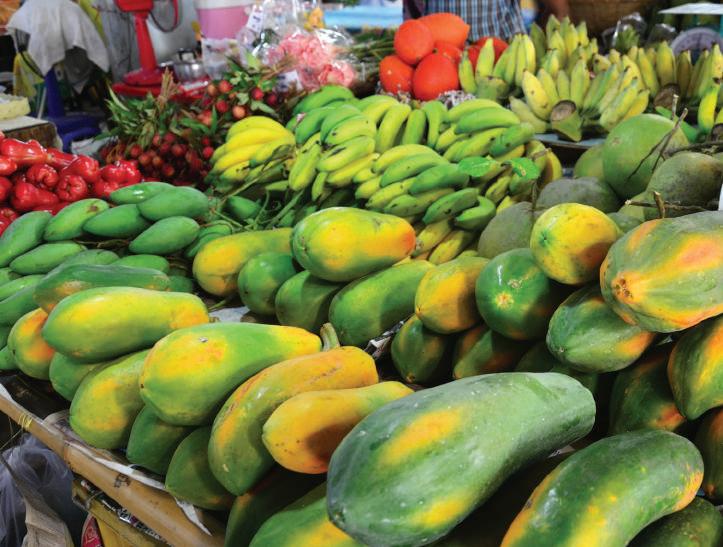
dishes Alabamians would recognize: pad thai, lo mein, fried rice, curry with rice, crab rangoon and egg rolls. And to drink, Thai iced tea, Thai coffee, sodas and water. She catered to her American customers from the start, shifting the balance of the lo mein to more noodles and less vegetables, the way her husband likes it. For the pad thai, she put the crushed peanuts in small cups on the side, to accommodate those with peanut allergies.
Yet for herself, Vining remains faithful to the food she was raised on in Laos, before coming to the U.S. at age 23 to earn a better living and to send money home. Vining’s mother arrived in 2015, so now mother and daughter garden together and cook Laotian food every day, despite running a Thai food truck and raising children who love pizza rolls. Vining’s mother, Thinh, still walks almost everywhere she goes because riding in cars makes her so carsick. Vining smiles. “In Laos, she walked, too. She didn’t ride a motorcycle. Everywhere, she walked.”
The family visits the Laotian temple in Irvington on most Sundays and for festivals, bringing food for the monks. The children learn ethics from the monks and enjoy picking out treats and treasures from a big bucket offered after the meal. The temple also hosts Laos New Year’s, a three-day celebration in April when everyone dons traditional Laotian dress, dances the old dances and savors Laotian food, consisting mostly of sticky rice, vegetables, spicy sauces, soups, and fruits like papayas and bananas.
Like many children of an immigrant parent, Vining’s kids live in a mix of American realities and Laotian customs. They speak English in school, watch American cartoons and spend summers swimming in the pool. But they can also sing the Laos National Anthem, which Vining taught them while driving around when they were little. They eat sticky rice, shop for mangoes at the local “Laos store,” call their grandma Tuu (short for the Laos word for grandmother) and listen to stories when Vining’s Laotian friends gather at the house, sitting in a huge circle out back, talking and laughing, eating and remembering. It’s what Vining misses most about living in Laos: the constant community. “When we came home after school and after work, all the neighbors would be out together, talking and hanging out. All the children would play together. One night, one neighbor cooked and invited everyone to share. The next night, another neighbor. You know, when you walk by, they call, ‘Come on, come eat!’ But here, we just come home and stay in the house and don’t see our neighbors at all.”
But lately, the food truck has expanded Vining’s sense of community. “I want to open every day,” she While Vining’s food truck sells warm and hearty dishes, her home table is often crowded with fresh papaya, mango and banana reminiscent of her days in Laos.
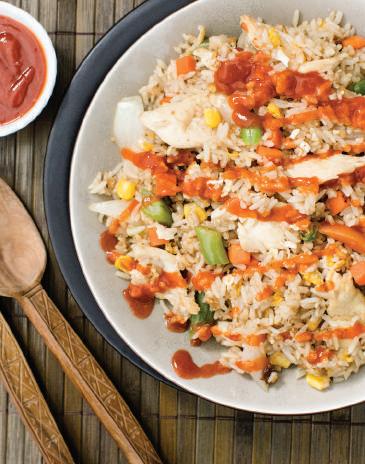
This page, top to bottom A fresh produce market in Laos. Vining’s chicken fried rice kicked up with a splatter of Sriracha. Opposite page, top to bottom Vining’s Thai chicken curry. A hungry customer stops by Tide Marine for a quick lunch. Farm fields in Laos.


says. I ask what inspires this devotion, and she replies, “The people. The customers are so friendly. I like hearing them say to Julia how much they enjoy the food. I see them come back. We have a lot of regular customers. One time the tickets were all the way down the window of the truck. Cooking for people makes me happy.”
When I ask where it comes from, that desire to cook for others, she answers immediately, “My heart!” And it comes from her parents, she emphasizes, who taught her to give freely, help others and provide for everyone during those communal neighborhood meals. Now, Vining often gives away egg rolls to the homeless and hungry. And she still works the way her dad taught her, cleaning as she goes and keeping everything organized. “So when you walk out, you just walk out.” She takes a breath and releases it, showing me how peaceful and easy it is to close up shop, when you’ve prepared for it.
Preparing the food truck takes a lot of work, all the shopping and prepping and cleaning. But Vining wouldn’t have it any other way. Unless she can get a bigger truck, or a second one. Because that she would do in a heartbeat. MB
Emily Blejwas is the director of the Alabama Folklife Association and author of “The Story of Alabama in Fourteen Foods.” She would like to thank Heather Smith and Sivbrang Trang for introducing her to Lith, and Amy Lyons and Julia Taylor for joining the interview.
CHICKEN CURRY
MAKES 1 16-OUNCE SERVING
1 8-ounce can coconut milk 1 teaspoon red curry paste 1 chicken breast, precooked 8 ounces water 2 teaspoons coconut sugar 2 tablespoons fish sauce 1 teaspoon chicken soup base mix 1 whole carrot, peeled and sliced 5 basil leaves 1/2 pound sliced bamboo
1. In a medium pot, bring coconut milk to a boil on medium heat. 2. Add curry paste. Stir until boiling. Add chicken and water; boil. 3. Add sugar, fish sauce, chicken soup base mix, carrot, basil and bamboo. Stir until combined. 4. Bring to a boil again. Serve with jasmine rice.

FRIED RICE
SERVES 2 1 tablespoon soy bean oil 1 garlic clove, chopped 1 egg 1/2 chicken breast, precooked 2 ounces frozen vegetables 1 yellow onion, sliced 8 ounces cooked jasmine rice 1/4 cup soy sauce 1 teaspoon oyster sauce 2 teaspoons sugar pinch of black pepper
1. Preheat large skillet to medium heat. Add grease to pan, then add garlic and egg. Let cook 30 seconds, then scramble. 2. Add cooked chicken, vegetables, onions and rice. Turn heat to high. Cook mixture about 3 minutes. Add soy sauce, oyster sauce, sugar and black pepper. 3. Cook for a couple of minutes or until mixture is hot.
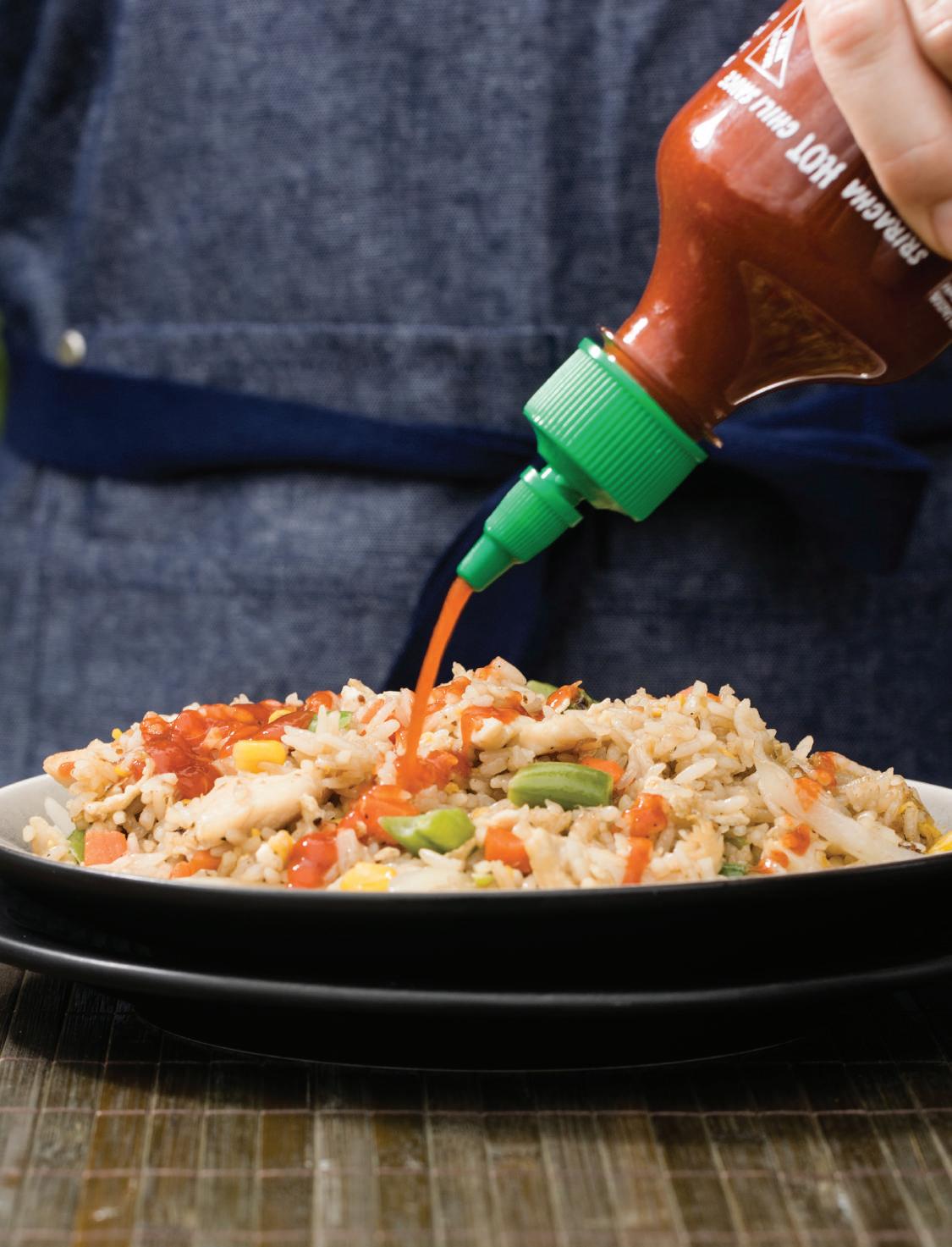
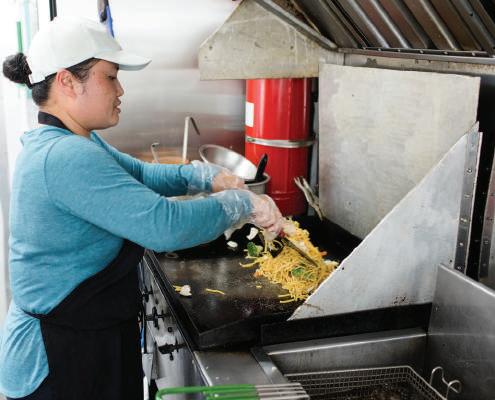
Follow’s Lith’s Asian Cuisine on Facebook to see where she will be rolling next! Favorite spots include Tide Marine in Bayou La Batre, Reney’s Honey Butter in West Mobile and Dority’s on Dauphin Island.

THAI TEA
Thai tea mix can be purchased from Asian grocery stores or from Amazon. It is a black tea flavored with spices and vanilla and has a deep orange color. MAKES 1 SERVING
4 tablespoons Thai tea mix 1 cup water, boiling half and half, to taste


Add Thai tea mix to boiling water. Remove from heat and let steep 30 minutes or to taste. Strain and discard loose tea and stir well. Add half and half to taste.











